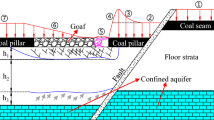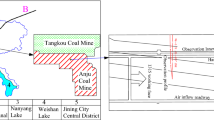Abstract
The water-bearing capacity and abnormal water-bearing area of the coal seam floor of working face no. II 632 at the Hengyuan coal mine was investigated using the network parallel electrical method. Based on the limit equilibrium theory and Mohr–Coulomb yield criterion, we obtained a critical water pressure formula. Using fault DF137 as an example, we found that the abnormal water-bearing phenomena around the working face was related to nearby faults and that the water inrush was mainly due to faults being activated during mining. The pathway of water inrush under the coupled effects of stress induced by mining and the confined water pressure was modelled in Flac3D based on the fluid structure interaction (FSI) method. Considering the economics and operational convenience, grouting the working face floor was recommended to prevent an inrush. Based on a geophysical evaluation, the grouting effectively prevented a potential inrush.
Zusammenfassung
Die wasserführende Kapazität und die unregelmäßig wasserführende Ebene des Kohleflözes der Arbeitsfläche Nr. II 632 in der Hengyuan-Kohlemine wurden unter Verwendung der netzparallelen elektrischen Methode untersucht. Basierend auf der Grenz-Gleichgewichtstheorie und dem Mohr-Coulomb-Ertragskriterium erhielten wir eine kritische Wasserdruckformel. Am Beispiel der Verwerfung DF137 fanden wir heraus, dass die unregelmäßige Wasserführung in der Umgebung der Abbaufläche mit nahegelegenen Störungszonen zusammenhing und dass der Wassereinbruch hauptsächlich auf Verwerfungen zurückzuführen war, die während des Abbaus aktiviert wurden. Der Weg des Wassereinstroms unter den miteinander gekoppelten Auswirkungen der durch den Bergbau induzierten Spannungen und des begrenzten Wasserdrucks wurde in Flac3D basierend auf der Fluidstrukturinteraktionsmethode (FSI-Methode) modelliert. In Anbetracht der Wirtschaftlichkeit und des Nutzungskomforts wurde empfohlen, den Arbeitsflächenboden zu verdichten, um einen Wassereinbruch zu verhindern. Basierend auf einer geophysikalischen Begutachtung wurde durch Injektion ein möglicher Wassereinbruch effektiv verhindert.
Resumen
La capacidad de retención de agua y el área de acumulación de agua anormal del piso de la veta de carbón de la cara de trabajo no. II 632 en la mina de carbón de Hengyuan se investigó utilizando el método eléctrico paralelo de red. Basados en la teoría de equilibrio límite y el criterio de rendimiento de Mohr-Coulomb, obtuvimos una fórmula crítica de presión de agua. Usando la falla DF137 como ejemplo, encontramos que los fenómenos anormales de acumulación de agua alrededor de la superficie de trabajo estaban relacionados con fallas cercanas y que la irrupción de agua se debió principalmente a fallas que se activaron durante la explotación minera. La vía de irrupción de agua bajo los efectos acoplados del estrés inducido por la minería y la presión de agua confinada se modeló en Flac3D basados en el método de interacción de estructura fluida (FSI). Teniendo en cuenta la economía y la conveniencia operativa, se recomendó aplicar lechada en el piso de la superficie de trabajo para evitar una irrupción. Basado en una evaluación geofísica, la lechada evitó de manera efectiva una posible irrupción.
抽象
利用网络平行电法研究了恒源矿II 632工作面煤层底板富水性和富水异常区。基于有限平衡理论和Mohr-Coulomb屈服准则,导出临界水压公式。以DF137断层为例,发现工作面周围异常富水区位于断层附近且底板突水主要由采矿诱发的断层活化引起。在Flac3D中用流固耦合法(FSI)模拟矿压与底板水压耦合作用形成突水通道过程。考虑经济和可操作性,建议采用注浆加固预防底板突水。借助于地球物理评价作用,注浆加固有效地预防了潜在底板突水。









Similar content being viewed by others
References
Guo BH, Cheng T, Wang L (2017) Physical simulation of water inrush through the mine floor from a confined aquifer. Mine Water Environ. https://doi.org/10.1007/s10230-017-0488-7
Hofmann GF, Scheepers LJ (2011) Simulating fault slip areas of mining induced seismic tremors using static boundary element numerical modelling. Mining Technol 120(1):53–64
Hu XY, Wang LG, Lu YL, Yu M (2014) Analysis of insidious fault activation and water inrush from the mining floor. J Chin Univ Min Technol 24(4):477–483
Lee D, Yim G-J, Ji S-W, Cheong Y-W (2012) Study on distribution characteristics of some water parameters properties of mine drainage in an oxidation pond, Hwangji–Yuchang coal mine, South Korea. Environ Earth Sci. https://doi.org/10.1007/s12665-012-1735-7
Li LC, Yang TH, Liang ZZ, Zhu WC, Tang CA (2011) Numerical investigation of groundwater outbursts near faults in underground coal mines. Int J Coal Geol 85(3–4):276–288
Li SC, Zhou ZQ, Li LP et al (2013) Risk assessment of water inrush in karst tunnels based on attribute synthetic evaluation system. Tunn Undergr Space Technol 38:50–58
Li WP, Liu Y, Qiao W et al (2017) An improved vulnerability assessment model for floor water bursting from a confined aquifer based on the water inrush coefficient method. Mine Water Environ. https://doi.org/10.1007/s10230-017-0463-3
Liu PG, Tao YZ, Shang MT, Yao M (2014) The calculation of mine water yield using the non-continuous flow theory. Environ Earth Sci 71:975–981. https://doi.org/10.1007/s12665-013-2592-8
Liu SL, Liu WT, Yin DW (2017) Numerical simulation of the lagging water inrush process from insidious fault in coal seam floor. Geotechnol Geol Eng 35:1013–1021. https://doi.org/10.1007/s10706-016-0156-x
Miao XX (2011) Method and practice of water preserved coal mining in arid and semi arid mining area. China Univ of Mining and Technology Press, Xuzhou (in Chinese)
Sun J, Wang LG, Hu Y (2019) Mechanical criteria and sensitivity analysis of water inrush through a mining fault above confined aquifers. Arab J Geosci 12(1):4
SACMSC (State Administration of Coal Mine Safety of China) (2009) Interpretation of the regulations of mine water disaster prevention. China Univ of Mining and Technology Press, Xuzhou, pp 227–236 (in Chinese)
Sainoki A, Hani SM (2014) Dynamic behaviour of mining-induced fault slip. Int J Rock Mech Min Sci 66(1):19–29
Wang XY, Wang TT, Wang Q, Liu XM, Li RZ, Liu BJ (2017) Evaluation of floor water inrush based on fractal theory and an improved analytic hierarchy process. Mine Water Environ 36:87–95
Wu Q, Guo X, Shen J, Xu S, Liu S, Zeng Y (2017) Risk assessment of water inrush from aquifers underlying the Gushuyuan coal mine, China. Mine Water Environ 36(1):96–103. https://doi.org/10.1007/s10230-016-0410-8
Xu JP, Liu SD, Wang B, Zhang P, Gui H (2012) Electrical monitoring criterion for water flow in faults activated by mining. Mine Water Environ 31:172–178
Yin SX, HU WY (2008) Study on water blocking performance and natural lift height of rock strata. Coal Geol Explor 36(1):34–36 (in Chinese)
Zhang R, Jiang ZQ, Zhou HY, Yang CW, Xiao SJ (2014) Groundwater outbursts from faults above a confined aquifer in the coal mining. Nat Hazards 71(3):1861–1872
Zhao Y, Li PF, Tian SM (2013) Prevention and treatment technologies of railway tunnel water inrush and mud gushing in China. J Rock Mech Geotech Eng 5(6):468–477
Zhou QL, Juan H, Arturo H (2017) The numerical analysis of fault-induced mine water inrush using the extended finite element method and fracture mechanics. Mine Water Environ. https://doi.org/10.1007/s10230-017-0461-5
Acknowledgements
This study was supported by the National Natural Science Foundation of China (No. 5140413), the special Subject Grant of National “973” Basic Research program of China (No. 2015CB251602), the Open Projects of State Key Laboratory For Geomechanics and Deep underground Engineering (No. SKLGDUEK1212), the Natural Science Foundation of Anhui Province (No. 1508085ME77), the Major Research Funding Project of Natural Science of Anhui Province University (No. KJ2018ZD010), and the National Science Technology Major (No. 2016X05043).
Author information
Authors and Affiliations
Corresponding author
Electronic supplementary material
Below is the link to the electronic supplementary material.
Rights and permissions
About this article
Cite this article
Hu, Y., Sun, J., Liu, W. et al. The Evolution and Prevention of Water Inrush Due to Fault Activation at Working Face No. II 632 in the Hengyuan Coal Mine. Mine Water Environ 38, 93–103 (2019). https://doi.org/10.1007/s10230-018-00579-w
Received:
Accepted:
Published:
Issue Date:
DOI: https://doi.org/10.1007/s10230-018-00579-w




